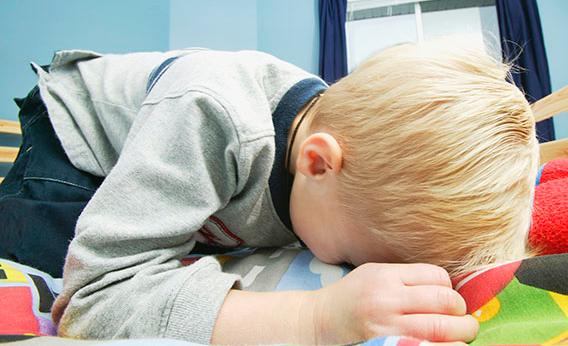
Show me that smile again.
Photo by Design Pics/Thinkstock.
I?m lucky: When I hear the phrase ?growing pains,? I think of Kirk Cameron, not night aches. I never suffered from growing pains as a child, and as far as I can tell, my 2-year-old doesn?t have them yet either. So sometimes I wonder: Are growing pains real? If so, what causes them? And how do I make sure my kid never has them, because I really don?t need another reason for screamy 3 a.m. wake-ups?
Growing pains are real?in fact, they?re pretty common. Estimates vary, but one Australian study found that as many as 37 percent of 4-to-6-year-olds experience these recurring aches, which typically afflict a child?s lower limbs in the afternoon or at night. Bizarrely, though, growing pains actually have nothing to do with growing?more on that later. And while they are nothing to worry about and usually disappear by the age of 14, growing pains can be confused with more serious health problems?so it?s good to know what they are and what they aren?t.
The term ?growing pains? first appeared in a book penned in 1823 by a French doctor, but since then physicians have realized that the peak of these pains, which is at around age 6, doesn?t correspond to a period of rapid growth. (A quarter of a person?s total growth actually happens during puberty). So it?s unlikely that growth has anything to do with growing pains, at least directly. But despite attempts to come up with more accurate monikers (such as ?noninflammatory pain syndrome of early childhood?), the old name stuck.
How frequently kids experience growing pains varies?some never get them, others get them five times a year, and a handful of poor souls have them every night. But timingwise, there are a few general rules. First, growing pains usually first appear during the preschool years. ?If a child is 8 and all of a sudden has pain at night, it is not growing pains,? explains Barbara Ostrov, a pediatric rheumatologist at Penn State University. Second, growing pains only happen in the afternoon or at night, so kids who complain of pain during the day or who wake up stiff or sore in the morning are almost certainly not experiencing growing pains. Most of the time, the pains disappear by around age 14, but some kids will have them throughout their teenage years. (Growing pains that are actually caused by growth spurts in adolescence?like Osgood-Schlatter disease?do not fall into the category of typical growing pains. Go figure.)
Growing pains are ?bilateral,? too, in that they typically affect both sides of the body. This doesn?t mean that both sides have to hurt every time?the right leg might hurt one night, and a few days later the left one will act up?but kids who only ever get pains on one side probably aren?t having growing pains. And growing pains aren?t visible. Your kid might be screaming his head off about his shin, but you should never actually see anything wrong with his shin. If you do?if you see redness or swelling or bruising, for instance?you should take your little one to the doctor, pronto.
So, the definition of ?growing pains? is based on when and where the pain happens, not on what causes it. And even today, no one is sure what produces growing pains, but there are several theories backed by (limited) research, and together they suggest that growing pains might have a range of physiological causes. One possibility is that kids who get growing pains have abnormally low pain thresholds. In a 2004 study, Philip Hashkes, at the time a pediatric rheumatologist at the Cleveland Clinic, tested the pain thresholds of 44 children with growing pains by putting pressure on various parts of their bodies, including points that are particularly sensitive to individuals who have chronic pain syndromes like fibromyalgia. After conducting similar tests on 46 children who didn?t have growing pains, Hashkes found that much less pressure was needed to incite pain in the children who had nightly growing pains. (Before you dismiss kids with low pain thresholds as ?crybabies,? keep in mind that research suggests that some people?especially redheads?have genetic mutations that do make them more sensitive to pain and resistant to painkillers.)
Since adults with fibromyalgia also have low pain thresholds, one question is whether kids who get growing pains are at an increased risk of suffering from chronic pain syndromes later in life. In a reassuring follow-up study that Hashkes conducted with 35 of these same 44 kids five years later, he found that when children stop having growing pains, their pain thresholds tend to normalize. (There were some kids who still experienced growing pains five years later, but their pain had lessened; although their pain thresholds were still lower than normal, they were higher than they had been.) None of the kids in his follow-up study had developed fibromyalgia.
19 kids and counting danny o brien alicia silverstone park slope food coop anchorman sequel safety not guaranteed lifehouse
No comments:
Post a Comment
Note: Only a member of this blog may post a comment.